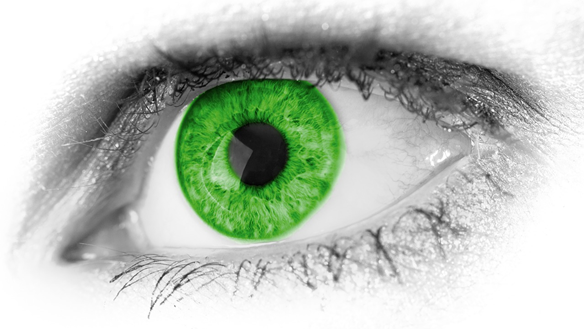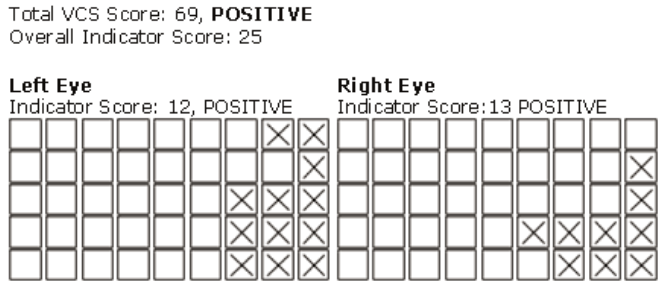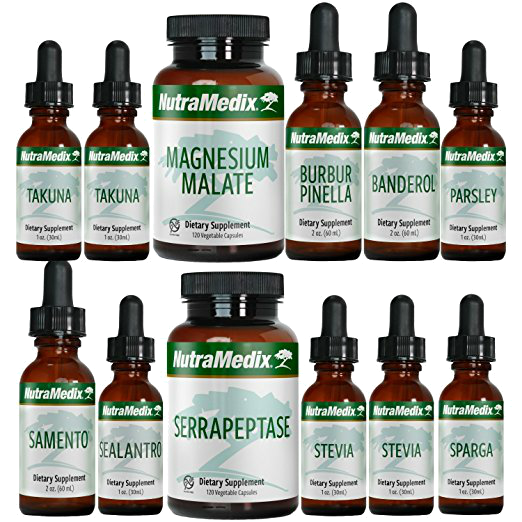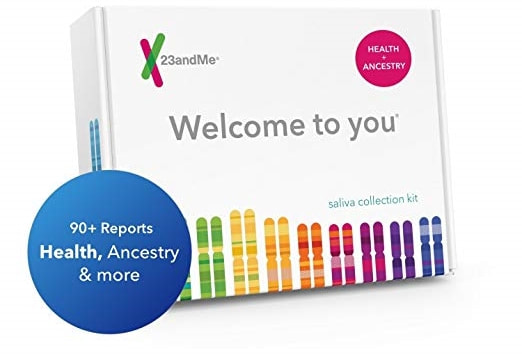VCS (Visual Contrast Sensitivity) Testing: What Mine Eyes May Tell
November 10, 2006 in Science/Research by Scott Forsgren | Comments
One of the challenges that many of us with Lyme disease face is the clear lack of useful diagnostic testing options. For many, finally getting the diagnosis of Lyme disease can be as challenging as finding one's unique path to recovery. Identifying tests that can serve as useful markers of the progression of the illness or as confirmation of a recovery underway is equally difficult.
Fortunately, one such option is inexpensive and can even be taken in the privacy of your own home. What is it? The VCS (Visual Contrast Sensitivity) test is a vision screening test that can be used to identify the potential presence of neurotoxins in the body. These neurotoxins negatively impact the body's neurological functioning and often lead to long-term, biotoxin-induced illnesses.
The test has been advocated by Dr. Ritchie C. Shoemaker, MD in conjunction with the work of H. Kenneth Hudnell, Ph.D. as a screening test which may help determine whether or not one's chronic health problems are caused by biotoxins. The test itself has been around for many years and was used by optometrists in the past for other purposes.
Biotoxins are created from numerous sources. These may include dinoflagellates, cyanobacteria, mold and fungi (Aspergillus, Penicillium, Stachybotrys, and others), ciguatera toxins from seafood, Borrelia burgdorferi (the causative agent implicated in Lyme disease), Babesia microti (a common Lyme co-infection) and others. Once these organisms enter the body, they produce biotoxins which can be a significant factor in the symptoms often seen in chronic illnesses.
The VCS test is a series of 90 patterns, 45 viewed by each eye, which will either have an up/down, tilted right, or tilted left series of lines represented at varying levels of contrast. When each image is displayed, the user then provides their perception of the direction of the pattern. People that have biotoxic-illnesses will often show a deficit on this test in that they will not see certain patterns that one without a biotoxic-illness would be able to recognize correctly.
A positive VCS test, combined with an exposure to biotoxins or biotoxin-producing organisms and a symptom picture involving multiple body systems, may provide the necessary information to lead one to a diagnosis. Though the test does not diagnose any specific illness, it is a useful screening tool that may show the potential exposure to neurotoxins. The results may be a signal to discuss further diagnostic options with your practitioner. If the VCS test reveals a deficit, a specific protocol, which may be of value to those with neurotoxin-mediated illnesses, may be appropriate.
If the test is positive, one may wish to consider a number of factors. One of these may be whether or not the genetic ability to remove these biotoxins from the body is present or not. For a number of people that are chronically ill with neurotoxin-mediated illnesses, there may be a genetic component involved. This can also be tested for with an HLA (human leukocyte antigen) panel. The HLA panel can provide additional information into whether or not a person is genetically susceptible to being challenged when it comes to the removal of biotoxins from the body. The results of this testing may also result in further tailoring of one's treatment protocol.
Sadly, many of us do not have this genetic ability to remove these biotoxins from the body. They may continue to circulate uninhibited and keep us feeling unwell.
Theoretically, if one could get rid of Borrelia burgdorferi infection with a short course of antibiotics, they may still remain sick for years to come simply due to the result of the biotoxins which will continue to remain in the body until appropriate binding agents are used in an attempt to help remove these toxins from the system. The specific toxin-binding agents are beyond the scope of this article on the VCS test, but further information is available at chronicneurotoxins.com.
It should also be noted that a NEGATIVE test result does not rule out the possibility of a biotoxin being involved in one's illness. The criteria for a POSITIVE result is set relatively high to avoid false positive results and thus the potential of a false negative result does exist. It is reported that this may be the case 5-10% of the time. The results may look something like those noted below where the items with a deficit noted are marked with "X".
Fortunately, one such option is inexpensive and can even be taken in the privacy of your own home. What is it? The VCS (Visual Contrast Sensitivity) test is a vision screening test that can be used to identify the potential presence of neurotoxins in the body. These neurotoxins negatively impact the body's neurological functioning and often lead to long-term, biotoxin-induced illnesses.
The test has been advocated by Dr. Ritchie C. Shoemaker, MD in conjunction with the work of H. Kenneth Hudnell, Ph.D. as a screening test which may help determine whether or not one's chronic health problems are caused by biotoxins. The test itself has been around for many years and was used by optometrists in the past for other purposes.
Biotoxins are created from numerous sources. These may include dinoflagellates, cyanobacteria, mold and fungi (Aspergillus, Penicillium, Stachybotrys, and others), ciguatera toxins from seafood, Borrelia burgdorferi (the causative agent implicated in Lyme disease), Babesia microti (a common Lyme co-infection) and others. Once these organisms enter the body, they produce biotoxins which can be a significant factor in the symptoms often seen in chronic illnesses.
The VCS test is a series of 90 patterns, 45 viewed by each eye, which will either have an up/down, tilted right, or tilted left series of lines represented at varying levels of contrast. When each image is displayed, the user then provides their perception of the direction of the pattern. People that have biotoxic-illnesses will often show a deficit on this test in that they will not see certain patterns that one without a biotoxic-illness would be able to recognize correctly.
A positive VCS test, combined with an exposure to biotoxins or biotoxin-producing organisms and a symptom picture involving multiple body systems, may provide the necessary information to lead one to a diagnosis. Though the test does not diagnose any specific illness, it is a useful screening tool that may show the potential exposure to neurotoxins. The results may be a signal to discuss further diagnostic options with your practitioner. If the VCS test reveals a deficit, a specific protocol, which may be of value to those with neurotoxin-mediated illnesses, may be appropriate.
If the test is positive, one may wish to consider a number of factors. One of these may be whether or not the genetic ability to remove these biotoxins from the body is present or not. For a number of people that are chronically ill with neurotoxin-mediated illnesses, there may be a genetic component involved. This can also be tested for with an HLA (human leukocyte antigen) panel. The HLA panel can provide additional information into whether or not a person is genetically susceptible to being challenged when it comes to the removal of biotoxins from the body. The results of this testing may also result in further tailoring of one's treatment protocol.
Sadly, many of us do not have this genetic ability to remove these biotoxins from the body. They may continue to circulate uninhibited and keep us feeling unwell.
Theoretically, if one could get rid of Borrelia burgdorferi infection with a short course of antibiotics, they may still remain sick for years to come simply due to the result of the biotoxins which will continue to remain in the body until appropriate binding agents are used in an attempt to help remove these toxins from the system. The specific toxin-binding agents are beyond the scope of this article on the VCS test, but further information is available at chronicneurotoxins.com.
It should also be noted that a NEGATIVE test result does not rule out the possibility of a biotoxin being involved in one's illness. The criteria for a POSITIVE result is set relatively high to avoid false positive results and thus the potential of a false negative result does exist. It is reported that this may be the case 5-10% of the time. The results may look something like those noted below where the items with a deficit noted are marked with "X".
The exact scoring algorithm is proprietary but the key thing for one to consider is simply whether or not one or both eyes shows up as "POSITIVE". In that event, a biotoxic-illness might be considered further. For me personally, I have done the test four times and have felt that it provided useful information as to my progress over time. My results have been as follows:
The test can be performed online: chronicneurotoxins.com. Options include one VCS test for $8.95 or 3 VCS tests and treatment protocols for $49.95. It should be noted that it is likely that one will want to take the test several times over the course of treatment as an indicator of progress. Other package options are also available.
Though there are people that may disagree with Dr. Shoemaker's recent comments on the use of long-term antibiotic treatment for Lyme disease, much of his work has practical application for those of us dealing with the condition. His experience with biotoxins being a major source of symptoms for people with chronic illness appears to be quite sound.
Further, I think it is important for patients to consider other potential contributing factors such as mold sensitivity that may be adding to their total body burden. Though I do believe that Lyme disease is a serious condition and may often require long-term therapy, I do appreciate the challenge given to all of us to consider other factors which may be contributing to our illnesses. It is important for us to leave no stone unturned when it comes to recovering our health. Fortunately, with the VCS test, we are offered another chance to consider the possibility that biotoxins may be a part of the puzzle.
Disclaimer: Neither Scott Forsgren or BetterHealthGuy.com are compensated in any way as a result of the purchase of the testing options mentioned in this article. The article is intended merely to provide information.
Note: Scott Forsgren has battled Lyme disease for the past ten years. He shares his story on his web site at BetterHealthGuy.com. Scott can also be reached at [email protected].
- August 2005: POSITIVE
- September 2005: POSITIVE
- April 2006: POSITIVE
- September 2006: NEGATIVE
The test can be performed online: chronicneurotoxins.com. Options include one VCS test for $8.95 or 3 VCS tests and treatment protocols for $49.95. It should be noted that it is likely that one will want to take the test several times over the course of treatment as an indicator of progress. Other package options are also available.
Though there are people that may disagree with Dr. Shoemaker's recent comments on the use of long-term antibiotic treatment for Lyme disease, much of his work has practical application for those of us dealing with the condition. His experience with biotoxins being a major source of symptoms for people with chronic illness appears to be quite sound.
Further, I think it is important for patients to consider other potential contributing factors such as mold sensitivity that may be adding to their total body burden. Though I do believe that Lyme disease is a serious condition and may often require long-term therapy, I do appreciate the challenge given to all of us to consider other factors which may be contributing to our illnesses. It is important for us to leave no stone unturned when it comes to recovering our health. Fortunately, with the VCS test, we are offered another chance to consider the possibility that biotoxins may be a part of the puzzle.
Disclaimer: Neither Scott Forsgren or BetterHealthGuy.com are compensated in any way as a result of the purchase of the testing options mentioned in this article. The article is intended merely to provide information.
Note: Scott Forsgren has battled Lyme disease for the past ten years. He shares his story on his web site at BetterHealthGuy.com. Scott can also be reached at [email protected].
About the author
Scott Forsgren (Author) is a health writer, advocate, and coach. He is the editor and founder of BetterHealthGuy.com where he shares his now 17 year journey through the world of Lyme disease and the myriad of factors that it often entails. He has been fortunate to have written for publications such as the Public Health Alert, Explore!, Bolen Report, and Townsend Letter. More information on his work is available at BetterHealthGuy.com.
latest posts
tags
Disclaimer: The information on this website is not a substitute for professional medical advice.
Always consult with your treating physician before altering any treatment protocol.
Always consult with your treating physician before altering any treatment protocol.









